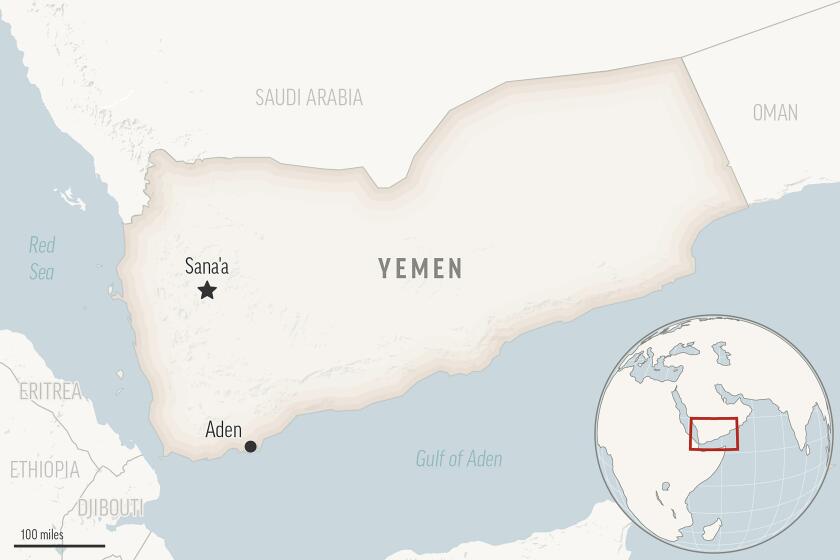Sky’s the Limit for Hot Asian Space Race
- Share via
TSUKUBA, Japan — Caged by yellow catwalks in a hangar outside Tokyo, Japan’s most hyped and technically advanced space project looks more like a bus-sized dog food can than a space station module.
But when launched into orbit three years from now, the research capsule will be the only part of the international space station designed, built and run by an Asian country.
Japan’s high-tech wizardry boosted it into that elite club of space travelers. Bristling with pride, Japan bills the vessel, called Kibo--or Hope--as Asia’s first manned spacecraft.
Yet as the 16-year, $4-billion venture entered the final phase of testing in November, Japan’s space program was faltering. And as an Asia-wide space race is just beginning to heat up, it’s all Japan can do to keep a tenuous lead.
“This project is very important,” says Hideo Nagasu, former director of Japan’s National Aerospace Laboratory. “We’ve spent so much time and money on this, we have to be successful.”
The Asian space race may lack the high-profile propaganda of the Cold War sprint for the moon. But it mirrors that showdown between the United States and the Soviet Union in one important way: It is driven more by strategic goals than scientific ones.
The list of contenders is long.
China wants to be the next country launching its own astronauts into space; India is on the verge of mastering the cryogenic technology needed to launch satellites or intercontinental ballistic missiles.
Even impoverished North Korea claims to have an unmanned satellite circling the globe in praise of its Great Leader.
And nearby Australia is fueling regional rivalries by trying to break into commercial launching with a new type of scram jet engine.
“There are several space races going on,” said space analyst Joan Johnson-Freese, of the Asia-Pacific Center for Security Studies. “There’s the prestige race and the technological race. The official reason for Japan’s space station is microgravity research. The real reason is that this is their foot in the door to a manned space program.”
Calling Kibo a manned spacecraft is a bit of a stretch.
While the vessel has room for four astronauts to conduct experiments, it will tentatively be launched by the U.S. space shuttle in three separate shots beginning in 2004.
Japan doesn’t have a rocket big enough to budge the 16-ton package and the country isn’t seriously entertaining plans to eventually launch its own astronauts.
China, on the other hand, has placed great prestige on and poured an undisclosed amount of resources into its secretive 31-year-old space program. Some estimates say China could be ready to put astronauts aloft in two years.
Japan’s $1.65 billion a year space program was shackled from its inception, in part by the country’s pacifist constitution. Human flights were off limits because the reentry technology needed to bring astronauts home safely was too closely linked with intercontinental ballistic missiles, Nagasu said.
But that thinking changed when North Korea lobbed a rocket over Japan in 1998. Japan not only became more interested in human space flight, it vowed to send up its first spy satellite by 2003.
To put its own probes in space, Japan has even embarked on a new rocket program, the H-2A, which could pit it against Europe and the United States in the lucrative commercial launching market.
If the Jan. 31 final test launch is a success, Japan will proceed with 11 scheduled operational launches through 2005.
Kibo mission commander Kumiaki Shiraki denies his project plays into Asia’s space race--but it’s clear what his expectations are.
“We need to accumulate the technology for manned missions, which will be essential to the further development of our program,” he said.
Kibo gives Japan access to the state-of-the-art outer space air conditioning, life-support and energy-supply systems used by NASA. And for the first time, Japan will be training its own astronauts for the space mission, instead of having NASA do the work.
China, long isolated by both the United States and Russia, at first had to develop portions of its space program from scratch and specializes in basic, but reliable, spacecraft,
By contrast, Japan has focused on high-tech gadgetry, often with mixed results.
It has successfully put a satellite in orbit around the moon and docked two satellites in space by remote control. But it also has a history of mechanical breakdowns, budget overruns and two failed launches, only recently reversed with the successful first liftoff of Japan’s next-generation H-2A rocket in August.
Kibo is considered a bright spot.
“Before this, Japan never had its own manned flight system,” boasts Shiraki, waving a hand at the hulk behind him in an assembly room the size of a sports stadium. “I’m proud.”
Two round windows at the end of Kibo’s 33-foot long pressured cabin peer out like eyes over a platform--or “back porch,” where a robot arm can carry out experiments exposed to the vacuum of space.
But even that feature, unique of all contributions to the international space station, shows just how far Japan has to go in being accepted as an equal, independent partner.
NASA has the right to use half of Kibo’s research facilities for its own experiments.
And perhaps more symbolic, Japan’s spacesuits, while emblazoned with rising sun flag on one shoulder, are also festooned with the U.S. stars-and-stripes on the other--something unthinkable in China.
More to Read
Sign up for Essential California
The most important California stories and recommendations in your inbox every morning.
You may occasionally receive promotional content from the Los Angeles Times.













